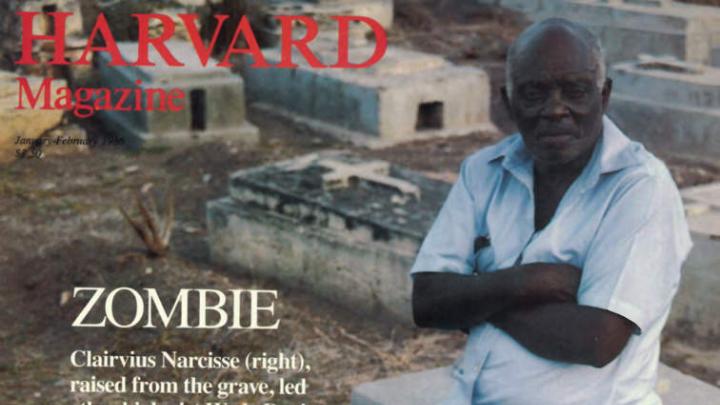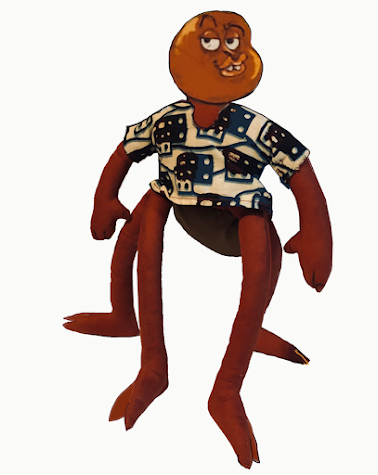AFRO-CARIBBEAN INFLUENCES:
Voodoo, True Zombies & Dreadlocks
Worldwide Afro-Caribbean practices began on two large Caribbean islands, French-speaking Haiti and next-door English-speaking Jamaica. However, the most pervasive concepts are Rastafarian dreadlocks, Haitian voodoo & zombies.
Zombies and Voodoo or Voudou are combined Indigenous Taíno practices which have greatly influenced popular American culture, especially through Hollywood movies, and the naming of 13 new pathogens, a set of 48,500 year old infectious viruses revitalized from thawing permafrost.
A true zombie was the verdict of a local medicine man, a bokor, a priest of Vodou or "Voodoo", another Amerindian-African collaboration of using endemic medicinal herbs, and spiritualism. The "victim" was a man who messed up royally, given a puffer fish potion, whose toxin made him seem dead. Buried, he was later dug up by the bokor and used like a slave.

Above:The cover of the January-February 1986 issue of Harvard Magazine, based on research in Haiti.
Photo of Clairvius Narcisse raised from the grave, led ethnobiologist Wade Davis to probe the secrets of Haiti's "living dead".Rastafarianism:Another Afro-Caribbean influence
Jamaica's reggae star, Bob Marley, was responsible for the popularizing of the wool-like natural matting of freshly washed hair, based on the teaching of the Biblical Israelite, Samson. In the Bible's Old Testament, Samson's strength was in his long, uncut hair, which, when forcefully cut by the Romans, he lost his strength. When Jamaican police arrested Rastafarians for ganja or marijuana possession, they would cruelly cut off their dreadlocks. This practice was outlawed.
The belief in dreadlocks came from the Jamaican Rastafarians belief that, "God made two animals with woolen hair, Africans, the Chosen People, and sheep. Since Christians say that Jesus the Christ was the 'Lamb of God' and (historically) described as having 'hair like a lamb' and 'feet of brass', like Black people, then, Jesus was Black like the Rasta", my late Rastafarian brother, Bobby said.
"We must locks-down to show our African strength! So, when sinners see our locks, it will put dread into their hearts!" he continued. Thus, the Rastafarian term, "Dreadlocks".
Jamaica's African Stories
Did Jamaica;s Anansi the Spider-Man want to become a Rasta after Bob Marley made that Jamaican religion popular, world-wide?
Anansi was hooked on reggae, and even sang some of Bob's songs. He especially liked "War", the Marley and the Wailers' lyric which came from a Haile Selassie speech in 1936 to the League Of Nations, that was the forerunner to the United Nations.
(To understand the meaning of the song, "War" which was a plea by Ethiopian Emperor, Ras Tafari Makenon a.k.a. Haile Selassie, ckick here: https://youtu.be/loFDn94oZJ0?si=-cGta3tBuATRbG03)
Alhhough Anansi began to also wear dreadlocks and carry a guitar, he was not into obeah.
But his youngest tri-racial son, Ticky-Ticky whose mom was a full-blood Jamaican Taíno woman, did have a meeting with Cuffy the Obeah-Man.
Anansi’s Son & Vodou:
Meeting the Obeah-Man
In my novel, "Ticky-Ticky's QUEST", when Ticky-Ticky introduced himself to Cuffy, the obeah-man, he said, to the young Spider-Boy,
"So... your father, Anansi is the son of a god?" Cuffy challenged.
"Yes... So? " Ticky-Ticky said.
"So, this make you a 'God-let'?" Cuffy sniggered.
"A what?" Ticky-Ticky asked, not knowhing where Cuffy was coming from.
"Well, Anansi is supposed to be the son of the Ashanti sky god, N'yame and the Earth goddess, Asase Ya... So, it stands to reason that when you have a pig. And you have it's son, it is a piglet. So this makes you a..." Cuffy jeered.
"Aww, shut up man! And gimme de potion!" Ticky-Ticky insisted.
Above: Jamaica's Cuffy the Obeah or Vodou-man with his zombi-making soursop or puffer fish. He intended to use the Taíno recipe for making Osebo the Terrible Leopard into a Haitian-inspired zombie.
Once a certified doctor of medicine, Cuffy was a researcher in Taíno herbal cures, Taíno-African Vodou or "Voodoo" from nearby Haiti; Santeria from next door Cuba; and Obeah from his own Jamaican homeland. The island's medical professionals were not amused. For this, he was kicked out of his medical practice. Here, he wanted to experiment with the puffer fish's Tetrodotoxin, an extremely potent poison (toxin) found mainly in the liver and sex organs (gonads) of some fish.
The Novel's Story
No brain-eating cannibals here. The true zombies came from Haiti's cultural mix between the Indigenous Taíno and imported West African traditions. In the story, Osebo the Terrible Leopard (below) is turned into a zombie by Cuffy the Obeah-Man, after being slipped a zombi-potion, taken for dead, buried, then dug up at night, just to do Cuffie's bidding. Ticky-Ticky gets in a few slaps to Osebo's cheeks, while the leopard is under the zombie influence. No more "killing under the influence of revenge" for Osebo.
The Story begins in a Jamaican classroom...
Anansi's son, Ticky-Ticky sat in his high school classroom on a rainy morning, daydreaming about his lost dad, who went missing just one year now, while on one of his numerous adventures. For this inattention, Ticky-Ticky's teacher, ruler in hand, admonishes him.
It all started with this classroom infraction of not paying attention. And responding rudely cutting his eyes at the teacher. Sent for a caning to the boy's school's Headmaster, Ticky-Ticky was told that he "must bring his father in." But, was Anansi even alive? He had been away for whole year on a search for many rich American spider-relatives. Maybe his cousin, Grandmother Spider of the Cherokee in North Carolina knew? Or, maybe, Spider Woman of the Hopi? At least, she may know about gold-rich "island" of La California?
However, the only first problem is how to find Anansi, especially when his main enemy, Osebo was on a quest to also corner and confront Anansi for embarrassing him in front of a lady in whom they were both courting. So, Osebo came after Ticky-Ticky for revenge.
Luckily, Ticky-Ticky escaped!
Now, here he sits with his best friend in school, Iggi, a shape-shifting Yamaye Taíno Rock Iguana. Popped, ghostly duppy balloon seeds float around them.
In this story, "Ticky-Ticky's QUEST", Anansi'ss son, Ticky-Ticky was forced to go to a local Onbeah-man. named Cuffy, who offered the spider-boy a way to find his father, Anansi. Cuffy uses a Taíno cohoba, a powdered snuffing tobacco-based potion to send TickyTicky to the Caribbean's Coabey, the Island of the Dead. There Ticky-Ticky meets the Lord of the Afterlife, Guayaba Maketaure, a god-relative. Was Anansi dead? Living in the Caribbean, was Anansi sent to the West Indian Island of the Afterlife?
 |
Above: Guayaba Maketaure, Lord of the Afterlife, seated in his bohio (round house) in front of his symbol, the guayaba or guava berry, his fruit of "sweetness and delight". Is he Ticky-Ticky's relative? Can he help to find Anansi? |
Above: Part 1 of a trilogy of the author's book on Anansi's son, Ticky-Ticky's Caribbean adventure. http://anansistories.com/Ticky_Ticky.html (Parts 2 & 3 which take Ticky-Ticky to North and Central American relatives, are in production.)
And remember...
 |
| Anansi the Entertainer with his back-up posse. The Con-doms, Me. Myself. and I&I |






































